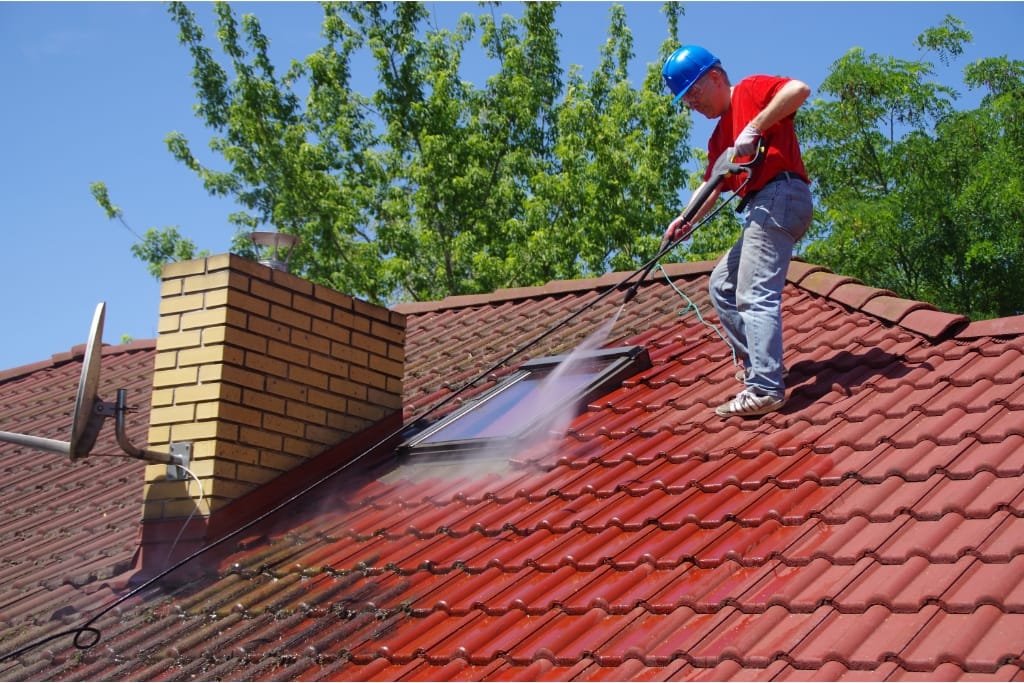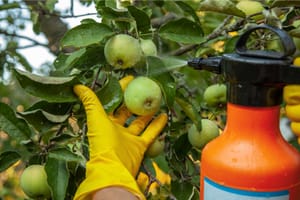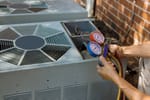Your roof works 24/7 to protect your home from rain, snow, wind, and blazing sun.
But like any hardworking part of your house, it needs regular maintenance to stay in top condition.
Roof treatment—including cleaning, sealing, and protective coatings—can extend your roof's lifespan by years and save you thousands in replacement costs.
Many homeowners wait until major damage occurs before taking action. However, recognizing the early warning signs can help you address issues before they become expensive problems.
Keep reading to discover 10 key indicators that your roof needs professional treatment, helping you make informed decisions about your home's protection.
1)) Dark Streaks And Stains Are Visible
Those unsightly black or dark green streaks running down your roof aren't just cosmetic issues.
These stains typically indicate algae, moss, or lichen growth, which can cause serious damage over time.
Algae feed on the limestone filler in asphalt shingles, gradually wearing away the protective granules.
Moss retains moisture against your roof surface, creating an environment where rot can develop.
In colder climates, this trapped moisture can freeze and expand, causing shingles to crack or lift.
If you notice these dark streaks, especially on the north-facing side of your roof where sunlight is limited, it's time to consider professional roof treatment.
Early intervention can prevent these organisms from spreading and causing structural damage.
2)) Granules Are Missing From Shingles
Asphalt shingles rely on protective granules to shield them from UV rays and weather damage.
Over time, these granules naturally wear away, but excessive loss is a red flag.
Check your gutters after heavy rain. If you find an unusual amount of granules—they look like coarse sand—your shingles may be deteriorating faster than normal.
You might also notice bare spots on your roof where the underlying asphalt is exposed.
Missing granules leave your roof vulnerable to UV damage, temperature fluctuations, and moisture penetration.
Roof treatment can help seal these exposed areas and prevent further deterioration.
3)) Shingles Are Curling Or Buckling
Healthy shingles should lie flat against your roof deck. When they start curling at the edges or buckling in the middle, it's a sign of aging, moisture damage, or poor ventilation.
Curling shingles create gaps where wind-driven rain can penetrate your roof system.
They're also more likely to blow off during storms, leaving vulnerable spots that need immediate attention.
This type of damage often occurs gradually, so regular roof inspections can help catch it early.
Professional roof treatment can address minor curling and buckling before replacement becomes necessary.
4)) Your Energy Bills Are Rising
A sudden spike in heating or cooling costs might point to roof problems. When your roof's protective barrier deteriorates, it can't effectively regulate your home's temperature.
Poor roof condition allows conditioned air to escape and outside air to enter through small gaps and cracks.
Your HVAC system works harder to maintain comfortable temperatures, driving up energy costs.
If you've noticed unexplained increases in your utility bills, consider having your roof evaluated.
Proper treatment can restore your roof's insulating properties and bring those energy costs back down.
5)) Interior Water Damage Is Present
Water stains on your ceiling or walls are obvious signs of roof problems, but damage isn't always immediately visible.
Check your attic regularly for signs of moisture, including water stains on rafters, wet insulation, or a musty smell.
Even small leaks can cause significant damage over time. Water can rot wooden structures, damage insulation, and create conditions for mold growth.
What starts as a minor issue can quickly become a major health and safety concern.
Don't wait for water to reach your living spaces. Early roof treatment can seal vulnerable areas and prevent costly interior damage.
6)) Flashing Is Damaged Or Missing
Flashing—the metal strips around chimneys, vents, and roof joints—creates a watertight seal at these vulnerable points.
When flashing becomes loose, cracked, or missing, water can easily penetrate your roof system.
Damaged flashing is one of the most common causes of roof leaks. High winds, temperature changes, and normal wear can cause flashing to separate from the roof surface or develop cracks.
Professional roof treatment often includes flashing inspection and repair.
Addressing flashing issues early can prevent water damage and extend your roof's life.
7)) Your Roof Is Over 15 Years Old
Most asphalt shingle roofs last 20-25 years with proper maintenance. If your roof is approaching or exceeding 15 years, it's time to be proactive about treatment and maintenance.
Older roofs are more susceptible to weather damage, granule loss, and general wear.
Regular treatment can help maximize your roof's remaining lifespan and delay expensive replacement.
Even if your older roof looks fine from the ground, a professional inspection can identify issues that aren't visible to untrained eyes.
Preventive treatment is always more cost-effective than emergency repairs.
8)) Daylight Shows Through Roof Boards
If you can see daylight through your roof boards from the attic, you have gaps that need immediate attention.
These openings allow rain, snow, and pests to enter your home.
Small gaps might seem insignificant, but they can quickly expand due to temperature changes, settling, and weather exposure.
What starts as a minor opening can become a major breach in your roof's protective barrier.
Professional roof treatment can seal these gaps and prevent them from growing larger.
Don't ignore even small amounts of visible daylight—they indicate your roof's integrity is compromised.
9)) Sagging Areas Are Visible
A sagging roof is a serious structural concern that requires immediate professional attention.
Sagging can indicate water damage to the roof deck, an overloaded structure, or compromised support beams.
Check your roofline from multiple angles around your property. Look for areas that appear to dip or sag compared to the rest of the roof.
Even minor sagging can indicate significant underlying problems.
While severe sagging might require structural repairs, early intervention through proper roof treatment can prevent minor issues from becoming major structural problems.
10)) Recent Severe Weather Damage
High winds, hail, heavy snow, and ice storms can cause immediate and long-term roof damage.
Even if your roof appears intact after severe weather, hidden damage might exist.
Hail can bruise shingles, making them more susceptible to future damage. High winds can loosen or remove shingles, flashing, and gutters.
Heavy snow loads can stress your roof structure and cause leaks when the snow melts.
After any severe weather event, have your roof professionally inspected. Many insurance policies cover storm damage, and prompt treatment can prevent minor damage from becoming major claims.
Conclusion
Your roof represents a significant investment in your home's protection and value.
Recognizing these warning signs early allows you to take proactive steps that can extend your roof's life and prevent costly damage.
Regular roof maintenance and treatment typically cost a fraction of roof replacement.
By addressing issues promptly, you can avoid emergency repairs, protect your home's interior, and maintain your property's value.
Don't wait for obvious signs of failure. Schedule a professional roof inspection at least once a year, and consider treatment whenever you notice any of these warning signs.
Download Our Free E-book!








